 The Rhino APC
Armoured Space Marine Carrier
Perhaps one of the most ubiquitous vehicles in Imperial service, the humble Rhino has been the mainstay of Space Marines armies since the time of the Great Crusade. Throughout the galaxy, servants of the Emperor take fire and steel to the enemies of Humanity, borne across the sell of uncounted battlefields in armoured fighting vehicles known as Rhinos These blessed vehicles carry the warriors of the Emperor safely through the inferno of shot and shell to bring the Emperor's fiery retribution upon his enemies. The Rhino has been on Imperial service for over ten thousand years and the origins of this faithful vehicle lie in the depths of Humanity's east, at the beginning of its expansion into space. Mankind's first steps into space were painfully slow, and even upon reaching other planets, colonisation was hampered by the lack of an all-purpose vehicle with which to explore these new worlds and the multitude of different terrain types encountered. However, all this was to change soon after the colonisation and exploration of Mars, with the development of warp drives and the evolution of the Standard Template Construct (STC) system. The exact origins of the STC system have been lost in the thousands of years since its first discovery, but its impact has ramifications that still resound in the 4.1 st Millennium. The sheer versatility of the STC system enabled the earliest colonists to simply input their needs and the STC system would design the most practical and robust solution to meet those requirements; be it a vehicle, shelter or any other item the colonists desired. The STC allowed the early colonists to create all manner of useful equipment from locally available materials and fuel them with whatever resources were to hand. As time passed, refinements were introduced into the system and it is said that many of the earliest STCs could in fact learn and self-evolve. STCs became more and more efficient and with its perfection, Mankind's expansion into space leapt forwards as starships became capable of reaching further and further into the galaxy. Mankind entered a golden age of exploration and colonisation and it seemed as though nothing could halt the expansion of Humanity's realm. 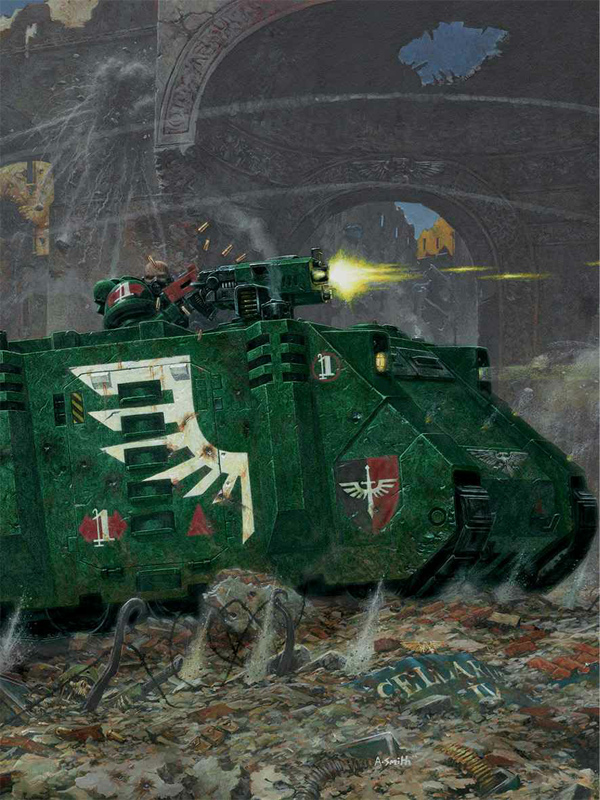
In conjunction with this, early colonisation of newly discovered worlds was facilitated by the creation of the RH1 N0 Tracked Exploration and Multi Defence vehicle - commonly referred to as the Rhino. At its most basic level, the Rhino is an armoured transport on tracks, designed to cope with all manner of hostile environments and cross almost any dangerous terrain while protecting those within. The efficiency of the design has resulted in the basic configuration of the Rhino remaining largely unchanged in the last ten thousand years. Capable of being constructed from almost any materials and powered by any partially combustible fuel, the Rhino has proven, time and time again. to be one of the most reliable and durable vehicles ever devised. The design soon spread, and within the space of a decade, almost every world within the burgeoning coalition of planets had its own locally produced variants of the Rhino. The military applications of this vehicle were quickly realised and the features that made the Rhino so appealing to the early colonists were perfectly suited for military operations. The armed forces of the day quickly adopted the Rhino as as armoured fighting vehicle and troop transport, fitting it with weapons and an augmented engine capacity. The earliest known use of the Rhino in battle is recorded in the faded script of the LiberArmorum by the armed forces of Torben's World against the indigenous xeno creatures that inhabited the fertile western plains of this fecund world. These regions had long been in dispute, with the aliens claiming that these lands were sacred to them and places of great holy significance. When several human townships built on the edges of the plains were attacked and their inhabitants murdered, retribution was swift and deadly.
The Rhino became the standard transport vehicle of human armies across the galaxy, with differing variants falling in and out of favour as the nature of Man's enemies and battlefields changed. The armies of Mankind spread Throughout the galaxy, and many hundreds of worlds were brought within this growing galactic empire. As more enemies were encountered, the STC systems provided these early armies with many different variants on the Rhino such as the Predator, Immolator and Whirlwind. All this was to come to an end, however, `n a period of now known as the Age of Strife that caused such a massive upheaval in the realm of Man can now only be guessed at, but its cataclysmic ffects cannot be underestimated. The many wars that erupted around this time engulfed the entire galaxy and not a single planet was spared the horror of rattle. Alliances and coalitions collapsed into internecine conflict, planets and systems waging war on one another for reasons that have since been lost to posterity. 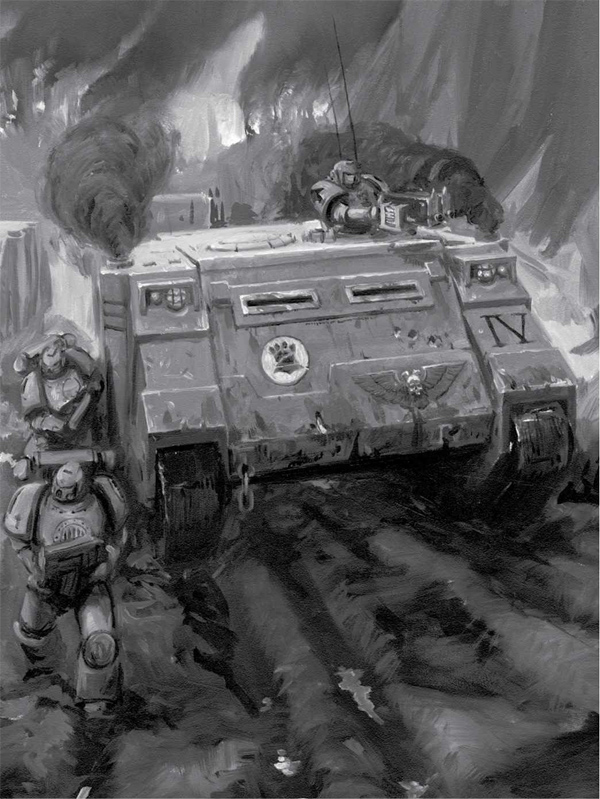
Whole planets were razed in the precious `STC` libraries destroyed or smashed by their enemies. Countless designs were lost and many of the STC systems were damaged beyond repair. By the time the wars subsided and Mankind had been united under the banner of the newly-revealed Emperor, the vast majority of STC systems had been destroyed and their priceless knowledge forgotten. Denied this most valuable resource, those few fragments of knowledge that remained became treasured relics, passed down from generation to generation, their very existence kept secret from the outside world. In time these fragments became legendary canticles of faith, their knowledge assuming the status of divinely inspired wisdom_ Hard copies of schematics and designs created by STC systems have lasted longer than the STCs themselves and have become the holy grail of the Adeptus Mechanicus, who eagerly seize on any scrap of information that might lead to the discovery of even the tiniest fragment of an STC's output. Over the millennia, scattered pieces of S T C lore have been recovered and ancient designs have slowly been reincorporated info :he Imperial inventory. The immolator tank used by the battle sisters of the Adeptus Sororitas is one such example, the databank containing its construction details discovered within an ancient factory complex on the world of Fornoth, during the Icaria Crusade. As knowledge of their construction faded from memory, attrition took its toll on the number of Rhinos throughout the galaxy. The rituals of maintenance became debased as the centuries passed and knowledge of the exact workings of the Rhinos passed into myth. Among those who retained the priceless knowledge of their construction were the Techmarines of the newly created Legiones Astartes and Tech Priests of the Adeptus Mechanicus, who established strict guidelines regarding the construction, consecration and maintenance of these valuable vehicles- Whether built in the Martian weapon-forges of the Adeptus Mechanicus or the fortress monasteries of the Space Marines, the builders of these holy vehicles know that the purity and spiritual welfare of the Rhino is as important as the skill of the artificers who construct it. 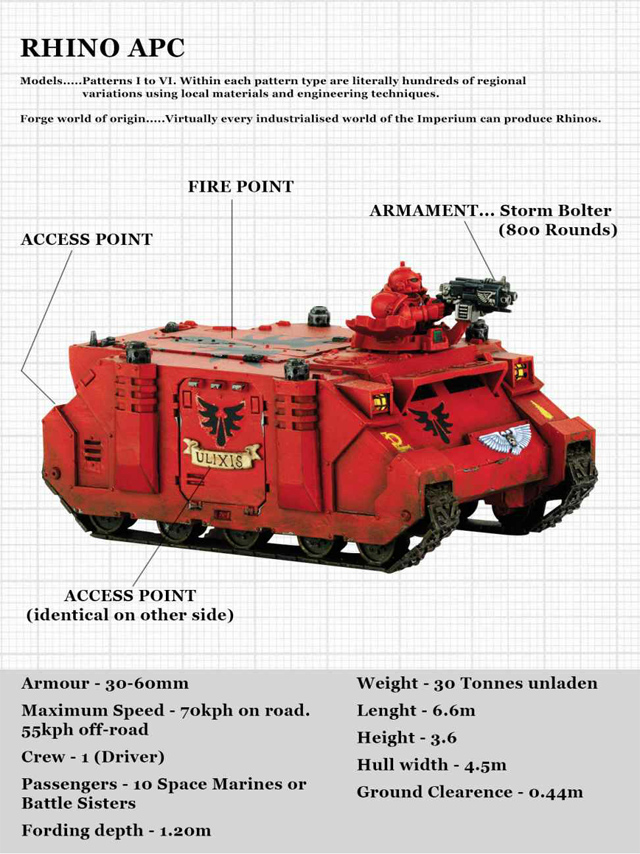
At every stage in a Rhino's assembly, sacred oils are applied and scented incense burnt to sanctify the process. Armoured panels are ritually inscribed with protective sigils as they are fixed into place and prayers are chanted as the bolts are turned in the cardinal directions. Every component is ritually checked and blessed before being installed, and as the Rhino roils to the end of its assembly nave, the ceremony of commission is prepared, whereupon the builders call upon the Spirit of the Machine to invest the Rhino with a measure of its power. The runes of activation are: hammered thrice upon its armoured hide and the engines fired as the third blow is struck. If the engine catches first time it is seen as a good omen for the vehicle and the warriors it will carry into- battle. As the Rhino rumbles out of the assembly hangars it is given a battle name worthy of such a sacred artefact and is then ready to depart for a life of war amongst the stars. Besides the Space Marines of the Adeptus Astartes only a select few imperial organisations now have access to Rhinos, the priceless technology involved in their construction and maintenance is too valuable to be entrusted to any but the most loyal and steadfast bodies of warriors. The Adeptus Sororitas and Adeptus Arbites have a number of Rhinos and they maintain a body of those sanctified and pure of heart to care for them. Years of training go towards achieving this respected position. Aspirants must learn how to divine the runes of engineering, memorise the liturgy of maintenance and constantly study the routine of service. It is a position of great honour to care for these vehicles and those that are carried into battle within one of these armoured transports are mindful of the spirits that inhabit the mechanical functions and blessed bolts that make up each one. Should a Rhino ever be lost in battle it is an occasion of great mourning for those entrusted with its care, and furious battles have been fought to reclaim the burned-out carcass of a Rhino simply to lay its spirit to rest. After the Battle of Naeuysk Gorge, fourteen Rhinos of the Imperial Fists had to be abandoned when traitor Space Marines from the Night Lords Legion ambushed the advancing column as it crossed the only bridge across the gorge. The attackers destroyed the lead and rear vehicles, trapping the rest in place. Previously placed demolition charges blew out the bridge supports and every Rhino on the bridge plummeted nearly a thousand metres into the gorge. The survivors were harried back to their base and the name of the Night Lords placed forever on the Chapter's Litany of Hatred. The following morning a daring mission involving an airborne assault across the gorge pushed back the Night Lords from the hills on the opposite side and allowed the Imperial Fists to bring up salvage units to start the recovery of their shattered vehicles and the bodies of their comrades. The battle in the hills raged for over thirty hours, with Imperial Fists' casualties amounting to almost 85% as they fought to give their Techmarines enough time to retrieve the fallen Rhinos. Many of the recovered vehicles were subsequently repaired and sent back into action, their battle spirits eager to avenge the ignominy of their earlier defeat. Rhinos that can be salvaged are brought back to the forge and each wound reverently repaired by skilled artificers, the battle scars worn with pride and their war-spirits honoured with the Litanies of Battle. As a result, many Rhinos have remained in service for thousands of years, becoming holy relics amongst the Chapters of Space Marines and other Imperial servants who rely on them. The oldest Rhino still in existence belongs to the Salamanders, and is known as Nocturne's Hammer. The Salamanders tell that it carried their legendary Primarch, Vulkan, into battle at the Siege of Devlin's Fastness, sallying out through the gates of the Imperial fortress to attack the foe. Nocturne's Hammer has seen over eight thousand years of action and now has a place of honour in the Chapter's reliquary on Prometheus, its armoured hide scarred by millennia of war. It is a great honour for a Techmarine to be chosen to minister to this holy vehicle and it is a duty that is solemnly observed. At the dawn of each new century, the Chapter's Techmarines gather in the reliquary and the Master of the Forge strikes the rune of activation upon the engine. It is seen as a portent of great doom should the engine `ail to catch first time. The Rhino continues to serve as the mainstay of many Imperial organisations and it is unlikely to be superseded without the discovery of a functioning STC database that will enable imperial servants to further refine and improve on its design. Until that day, the faithful Rhino will continue to carry the warriors of the Emperor into battle, proof against the weapons of their foes and ready to bring the wrath of the Master of Mankind upon his blasphemous enemies. 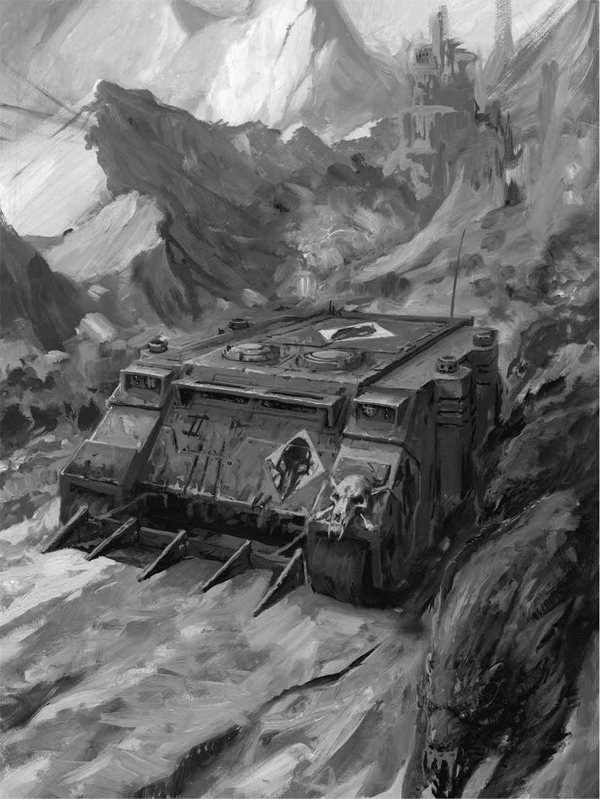
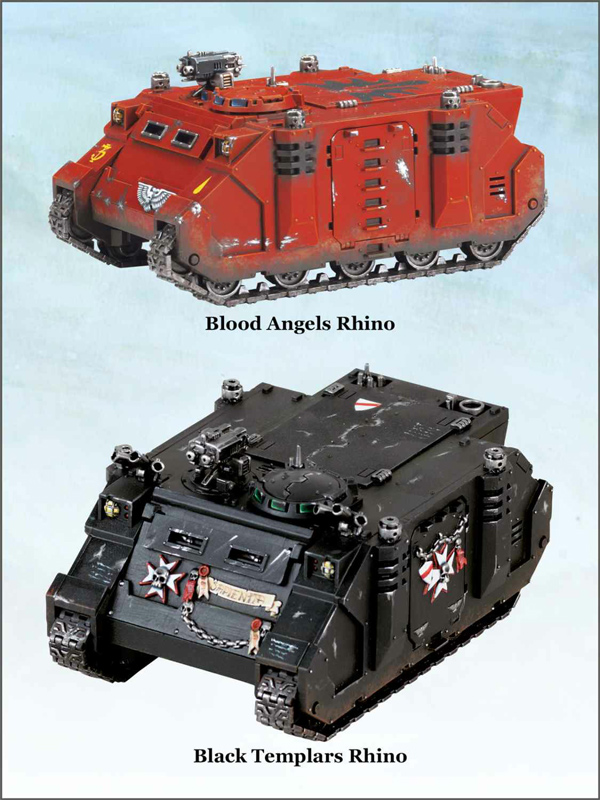
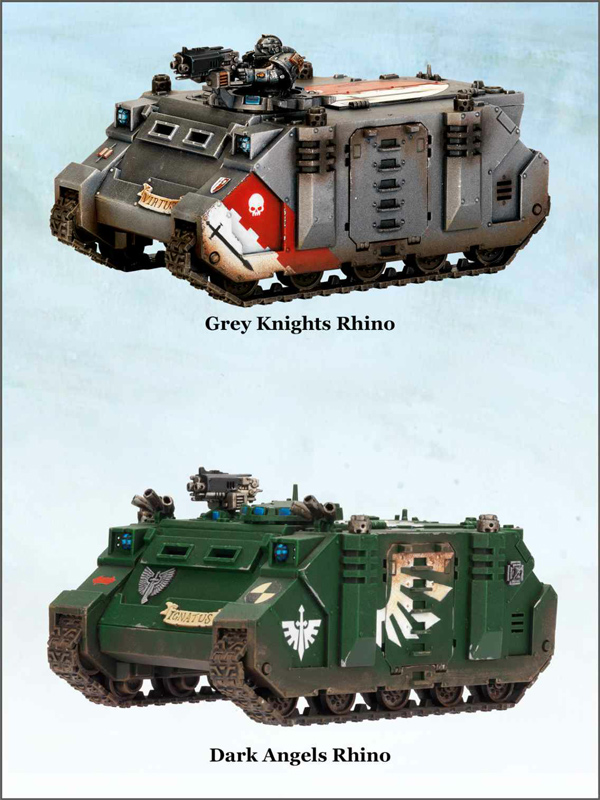
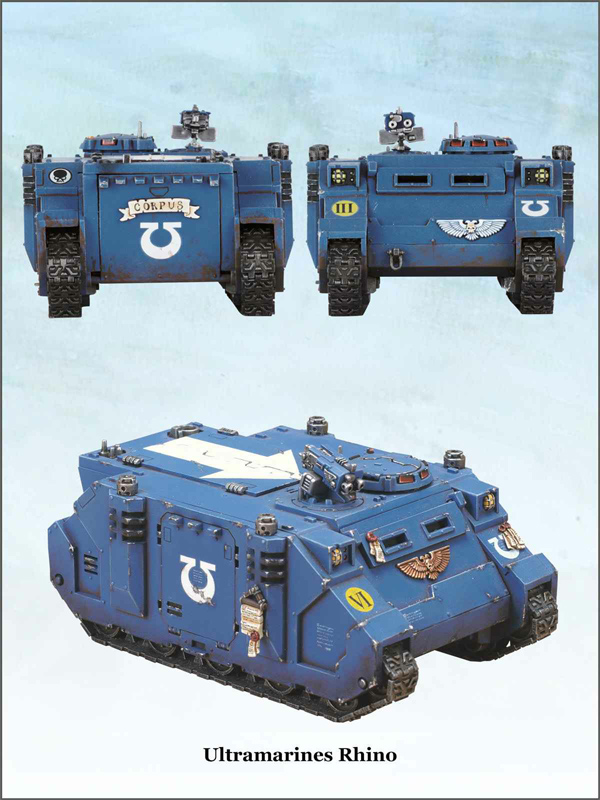
|
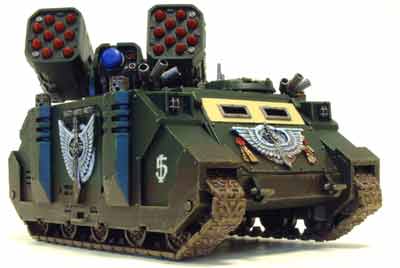 Three
hundred Rhinos were despatched across the plains to the largest alien
settlement. Such was the speed of the Rhinos, that the aliens had, no
foreknowledge of the attack and were caught completely by surprise.
The aliens' technology was equivalent to that of a black powder society
and their firearms would have wreaked havoc in the ranks of the human
troopers, but for the protection of their armoured vehicles. The Rhinos
surrounded the settlement and poured their firepower into the flimsily-constructed
dwellings, before smashing through them and disgorging nearly three
thousand troopers. With the destruction of this settlement, the remainder
of the aliens were soon eliminated and the colonisation of Torben's
World progressed with no further interference. News of this victory
soon spread and the tactics of using the Rhino in battle became further
refined.
Three
hundred Rhinos were despatched across the plains to the largest alien
settlement. Such was the speed of the Rhinos, that the aliens had, no
foreknowledge of the attack and were caught completely by surprise.
The aliens' technology was equivalent to that of a black powder society
and their firearms would have wreaked havoc in the ranks of the human
troopers, but for the protection of their armoured vehicles. The Rhinos
surrounded the settlement and poured their firepower into the flimsily-constructed
dwellings, before smashing through them and disgorging nearly three
thousand troopers. With the destruction of this settlement, the remainder
of the aliens were soon eliminated and the colonisation of Torben's
World progressed with no further interference. News of this victory
soon spread and the tactics of using the Rhino in battle became further
refined. 